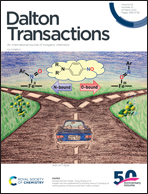Luminescent naphthalimide-tagged ruthenium(ii)–arene complexes: cellular imaging, photocytotoxicity and transferrin binding†
Abstract
Two water-soluble piano-stool shaped ruthenium(II)–arene complexes, [RuII(η6-p-cymene)(L)Cl2] [RuLCl] and [RuII(η6-p-cymene)(L)(PTA)Cl] [RuLPTA], were designed as emissive photocytotoxic agents tagged with morpholine as the lysosome targeting moiety. Here, L = N-(2-morpholinoethyl)-4-(2-aminoethyl)amino-naphthalimide, and PTA = 1,3,5-triaza-7-phosphatricyclo-[3.3.1.1]decane. The crystal structure of [RuLCl] exhibits the pseudooctahedral ‘three-legged piano-stool’ geometry, wherein Ru(II) is bound to the η6-p-cymene moiety as a base and two chlorides and the amine-N of the ligand L occupies the three legs of the stool. The complexes exhibited both the possibility of covalent adduct formation via the hydrolyzed Ru–Cl bond and non-covalent intercalation binding through planar naphthalimide moieties. The complexes showed enhanced photo-cytotoxicity under low-power blue LED light irradiation (λmax = 448 nm) mediated by 1O2, thereby acting as potential PDT agents. Fluorescence microscopy studies revealed that luminescent complexes preferentially localized in both the lysosomes and nucleus for effectively targeting and damaging the nuclear DNA for PDT effects. Due to enhanced lipophilicity of [RuLCl], it showed higher internalization into MCF-7 cell, measured in terms of the ruthenium content using ICP-MS. The interaction of the complexes with human transferrin (hTf) proteins was studied through molecular docking calculations, suggesting favorable binding through histidine residues and possible internalization into cancer cells via TfR-mediated endocytosis. The luminescence properties of the complexes were well-utilized to study their cellular uptake mechanism via endocytosis using fluorescence microscopy.



 Please wait while we load your content...
Please wait while we load your content...